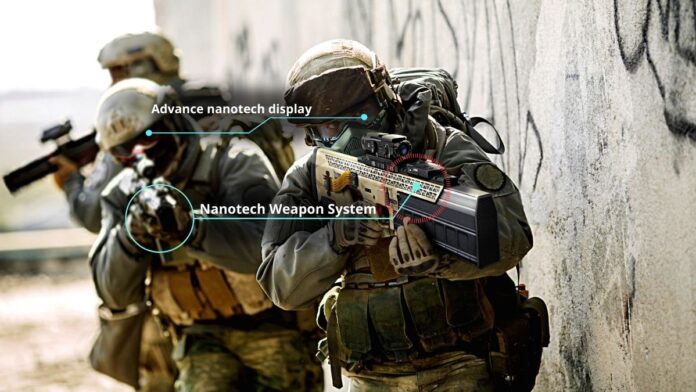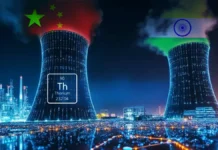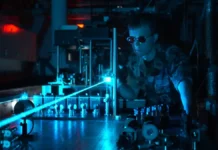
The use and advancements of Nanotechnology in warfare and defense have led to the categorized development of many nano-weapons with classifications varying from; small robotic machines, hyper-reactive explosives, and electromagnetic super-materials. Over the past two decades, numerous countries have rapidly funded military applications of this technology, including; China, the United Kingdom, Russia, and the United States.
The U.S. government has been recognized as a leader in research and development in this area. However, it has now moved closer to international competition because, while there is a growing appreciation of nanotechnology, on the other hand, the global impact of potential benefits or dangers of its use and issues related to safety and the environment are also being discussed. So what is meant by nanotechnology in future warfare and defense? Know in this article.
Contents
What is meant by Nanotechnology in Warfare and Defense?
Nanotechnology in warfare is a branch of nanoscience and technology in which molecular systems are designed, produced, and created to fit a nano-scale (1-100 nm). The application of such technology, specifically in warfare and defense, has paved the way for future research in weaponization.
Read more about Nanotechnology in this article – Nanotechnology: Manipulating Atoms and Molecules.
Advancements in warfare by using Nanotechnology
Advancements in warfare using Nanotechnology have led to the categorized development of such nano-weapons with classifications varying from; small robotic machines, hyper-reactive explosives, and electromagnetic super-materials. With this technological growth have emerged implications of associated risks and consequences, as well as regulation to combat these effects. These impacts give rise to issues concerning global security, the safety of society, and the environment. Therefore, legislation may need to be constantly monitored to keep up with nanoscience’s dynamic growth and development due to its potential benefits or dangers. Anticipating such impacts through regulation would ‘prevent irreversible damages’ of implementing defense-related nanotechnology in warfare.
The defense industry is now gradually improving the usage of nanotechnology. Thus, the trade between countries has been valued at nearly $3 billion during the last few years. Because it is an area with multiple defensive applications, its use will only grow exponentially.
Historical Research and Development of Nanotechnology in Warfare and Defense
Historical Research and development of nanotechnology in Warfare and Defense has been rapid and expansive. Over the past two decades, numerous countries have funded military applications of this technology, including; China, the United Kingdom, Russia, and most notably, the United States. The U.S. government has been considered a research and development leader in this area; however, now approached by international competition as an appreciation of nanotechnology’s eminence increases. Therefore, the growth of this sphere has a dominant platform at the forefront of military interests in the use.
Between 2001 and 2004, approximately 60 countries globally implemented national nanotechnology programs. According to R.D Shelton, an international technology assessor, research and development in this area, “It has become a socio-economic target…an area of intense international collaboration and competition”. As of 2017, data showed 4725 patents published in USPTO by the USA alone, maintaining their position as a leader in nanotechnology for over 20 years.
In India
Considering the underlying salience of nanotechnology, even India has been putting in a consistent effort in the field. The potential of Nanotechnology in India was realized by 2001 when the government of India set up NSTI (Nanoscience and Technology Initiative). Since then, India has come a long way. DRDO is carrying out extensive work in nanotechnology to enhance its application in the defense sector.
Primary focus areas have been NBC (Nuclear, biological, and Chemical) attack protection devices, stealth and camouflage, sensors, high-energy applications, nanoelectronics, and structural applications. DRDO has also set up a nano research and production facility in various parts of India. A Bengaluru-based Log-9 Materials startup is also collaborating with the defense industry to help it build multiple products and applications while conserving energy. However, the progress made by the country is not enough, and the process needs to be accelerated.
In China
In 2018, Beijing’s Tsinghua University released its findings, showing that they could handle more than 800 tons with 1cm carbon nanotubes. The scientific nanotechnology team hinted at aerospace and armor-boosting applications, showing promise for defense-related nano-weapons. The Chinese Academy of Science’s Vice President Chunli Bai has stated the need to close the gap between “basic research and application“ for China to advance its global competitiveness in nanotechnology.
In the United States
In 2000, the United States government developed a National Nanotechnology Initiative to focus funding towards the development of nanoscience and its technology, with a heavy focus on utilizing the potential of nano-weapons. This initial U.S. proposal has now grown to coordinate the application of nanotechnology in numerous defense programs and all military factions, including the Air Force, Army, and Navy. From 2001 through 2014, the U.S. government contributed around $19.4 billion to nanoscience and developing and manufacturing nano-weapons for military defense. Furthermore, the 21st Century Nanotechnology Research and Development Act (2003) envisions the United States continuing its leadership in the field of nanotechnology through national collaboration, productivity, and competitiveness, to maintain this dominance.
Current Research & Development of Nanotechnology in Warfare and Defense
Most recent research into military nanotechnological weapons includes the production of defensive military apparatus to enhance existing designs of lightweight, flexible, and durable materials. In addition, these innovative designs are equipped with features to improve offensive strategy through sensing devices and to manipulate electromechanical properties. Military Applications of Nanotechnology are as below:
Nanotechnology in Military Intelligence and Communication Devices
Nanotechnology designed for advanced communication is expected to equip soldiers and vehicles with micro antenna rays, tags for remote identification, acoustic arrays, micro GPS receivers, and wireless communication. In addition, nanotech facilitates more accessible defense-related communications due to lower energy consumption, lightweight and power efficiency, and is smaller and cheaper to manufacture. The specific military uses of this technology include aerospace applications such as; solid oxide fuel cells to provide three times the energy, surveillance cameras on microchips, performance monitors, and cameras as light as 18g.
While the potential applications are unlimited, some potential military nanotechnology applications are already quite advanced and will come into play much sooner than others. One example of this is sensors – many sensors have already been developed that take advantage of the unique properties of nanomaterials to become smaller and more sensitive compared to conventional technology. Portable, efficient sensors will be highly valuable to military field operatives, for example:
- Susceptible infrared thermal sensors
- Small, lightweight accelerometers and GPS for motion and position sensing
- Miniature high-performance camera systems
- Biochemical sensors
- Health-monitoring sensors and drug/nutrition delivery systems
Nanotechnology in military uniforms, battle suits, and body armor
The Institute for Soldier Nanotechnologies (ISN), deriving from a partnership between the United States Army and MIT, provided an opportunity to focus funding and research activities on developing armor to increase soldier survival. Each of the seven teams produces innovative enhancements for different aspects of a future U.S. soldier bodysuit. These additional characteristics include energy-absorbing material protecting from blasts or ammunition shocks, engineered sensors to detect chemicals and toxins, and built-in nanodevices to identify personal medical issues such as hemorrhages and fractures. This suit would be made possible with advanced nanomaterials such as carbon nanotubes woven into fibers, allowing strengthened structural capacities and flexibility; however, preparation becomes an issue due to the inability to use automated manufacturing.
Other Possible Future Applications
Other possible future applications that researchers, engineers, and scientists talk about are:
- Smart skin materials
- Adaptive camouflage
- Adaptive structured small robotic machines
- Hyper-reactive explosives
- Electromagnetic super-materials
- Nano-machines to mimic human muscle action in an exoskeleton
- Stealth coatings
- Self-healing (self-repair) material
Conclusion
Nanotechnology is a revolutionary technology, and its use in warfare promises economic growth however comes with an increased threat to international security and peacekeeping. In addition, the rapid emergence of new nanotechnologies has sparked discussion surrounding the impacts of such developments on geopolitics, ethics, and the environment.
This technological growth has emerged with implications of associated risks and consequences, as well as regulation to combat these effects. These impacts give rise to issues concerning global security, the safety of society, and the environment. Legislation may need to be constantly monitored to keep up with nanoscience’s dynamic growth and development due to its potential benefits or dangers. Anticipating such impacts through regulation would ‘prevent irreversible damages’ of implementing defense-related nanotechnology in warfare. So is the growth of the nano-weapons sector a powerful platform at the forefront of military interests and the use or abuse of its power? Please comment below.
Sources
- Carafano J. “Nanotechnology and National Security: Small Changes, Big Impact.” The Heritage Foundation.
- Nichols G (Summer 2017). “Nanotechnology and the New Arms Race.” HDAIC. 4: 19.
- “JOTS v41n1 – Military And National Security Implications Of Nanotechnology”. scholar.lib.vt.edu.
- “What is Nanotechnology? | Nano”. www.nano.gov.
- Research and Markets,” Global Nano Technology Market 2018-2024″, www.prnewswire.com, May 02, 2018.
- Roco M (2010). “Nanotechnology Research Directions for Societal Needs in 2020” (PDF). WTEC.
- StatNano. (2018, March 04). Top Ten Countries in Nanotechnology Patents in 2017. https://statnano.com/news/62082.
- Kar, S. (2017, December 13). Indian defense to use nanotechnology ties up with startup Log 9. The Economic Times.
- DRDO. (n.d.). Nanotechnology for removal of contaminants from water and mosquito larvicidal agents.
- Bai Y, Zhang R, Ye X, Zhu Z, Xie H, Shen B, Cai D, Liu B, Zhang C, Jia Z, Zhang S, Li X, Wei F (July 2018). “Carbon nanotube bundles with tensile strength over 80 GPa”. Nature Nanotechnology. 13 (7): 589–595. Bibcode:2018NatNa..13..589B. DOI:10.1038/s41565-018-0141-z. PMID 29760522.
- “China ‘has the world’s strongest fiber that can haul a space elevator.” South China Morning Post. 2018-10-26.
- “China focus: China aims high in nanotechnology – Xinhua | English.news.cn”. www.xinhuanet.com.
- Sargent JF (2014). “The National Nanotechnology Initiative: Overview, Reauthorization, and Appropriations Issues” (PDF). Congressional Research Service.
- “Text of S. 189 (108th): 21st Century Nanotechnology Research and Development Act (Passed Congress version)”. GovTrack.us.
- Simonis F (2006). “Nanotechnology innovation opportunities for tomorrow’s defense” (PDF). TNO Science and Industry.
- Mustafa AA (2017). “Nanotechnology in Communication Engineering: Issues, Applications, and Future Possibilities.” World Scientific News. 66: 134–148.
- Jha AR (2008). MEMS and Nanotechnology-Based Sensors and Devices for Communications, Medical, and Aerospace Applications. USA: Taylor and Francis Group. pp. 37–38. ISBN 978-0-8493-8069-3.
- “MIT Reports to the President 2003–2004” (PDF). Institute for Soldier Nanotechnologies. 2004.
- Luo X (2019). “Multifunctional Fabrics of Carbon Nanotube Fibers.” Journal of Materials Chemistry. 11: 9617.
FACT CHECK: We strive for accuracy and fairness. But if you see something that doesn’t look right, please Contact us.
DISCLOSURE: This Article may contain affiliate links and Sponsored ads, to know more please read our Privacy Policy.
Stay Updated: Follow our WhatsApp Channel and Telegram Channel.












Nanotechnology is the future.